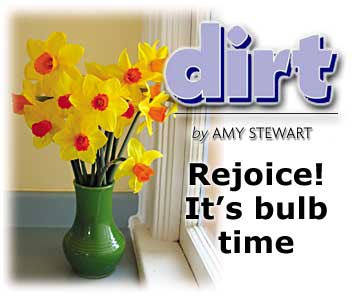|

COVER STORY | IN
THE NEWS | DIRT | ARTBEAT
TALK OF THE
TABLE | THE HUM | CALENDAR
October 5, 2006

I'm in denial about
the fact that summer is over and the first day of fall is fast
approaching. It would be easy to wallow in this denial until
my mother called to ask me what I was bringing to Thanksgiving
except for one thing: bulbs. They're in nurseries this month.
If you don't plant them now, you won't get another chance until
next fall. And even though buying bulbs and bringing them home
and burying them in the ground is an act of surrender to the
inevitable change in seasons, it's also a very hopeful act, one
that means that spring will get here eventually, and when it
does the garden's going to look fabulous.
Right now, the bulbs to plant are daffodils, tulips,
hyacinths, freesia and maybe some spring-blooming crocuses. Bulbs
aren't complicated, but they do have a few special needs. Here's
what you need to know:
Choose big bulbs.
The bigger the bulb, the bigger the flower. If the bulb has an
offset (a smaller bulb) attached to it, great. It'll probably
bloom a year or two later. Don't pull those offsets apart --
leave them attached when you plant.
Inspect for disease.
Don't plant bulbs with soft spots or blotches. If it looks sick,
it is.
Pick up some food.
A little organic fertilizer that has been specially formulated
for bulbs will give them the nutrition they need and help balance
the pH right around the bulb, making it easier for them to access
nutrients in the soil.
Prepare the ground.
Bulbs really do need good drainage, and if you've got clay soil
that tends to stay soggy all winter long, they could rot. Work
in some organic soil conditioner, and consider planting on a
sunny slope. Whatever you do, don't plant in a low, shady area
that turns into a bog when it rains.
Chill. Tulips in
particular will bloom better if they get a nice long winter chill
-- one that your garden might not be able to provide them. Consider
keeping them in the fridge for 6-8 weeks before planting. Daffodils
can go in the ground right now -- no chilling period needed.
Dig. It's important
to plant bulbs to the right depth. Most of them come with planting
instructions, but the general rule is to dig a hole about twice
as deep as the bulb is tall.
Start some indoors.
Paperwhite narcissus and hyacinths will grow indoors in nothing
but water. You can buy special vases designed to hold just one
hyacinth bulb, and most nurseries also sell kits with glass vases
and pebbles for starting paperwhites. Just keep them in a dark
place for a couple of weeks while they grow roots, then bring
them out and enjoy them.
You can still get a good selection of bulbs at
nurseries around town, but there are also some good mail-order
sources of interesting and unusual bulbs. In particular, I like:
Brent and Becky's Bulbs, a Virginia-based
supplier of hard-to-find bulbs. They're a good source for what
are called "species tulips," meaning smaller, wild
tulips that come back year after year, as opposed to the big,
bright hybrids that bloom gloriously the first year but often
don't return the following spring. Contact them at 804-693-3966
or www.brentandbeckysbulbs.com.
The Southern Bulb Company understands that
we don't all live in climates with long, hard freezes and warm
summers. They brag that they don't buy their bulbs from Holland
-- they grow them in Texas! That's right, Texas. And they quite
thoughtfully organize their bulbs by USDA climate zone, so that
those of us in Zone 9 can go right to the bulbs that will do
best for us. I particularly like their spider lilies and fragrant
daffodils. Call 866-406-BULB or visit www.southernbulbs.com.
Old House Gardens will make a rare bulb
addict out of any novice gardener. Owner Scott Kunst is entirely
dedicated to saving near-extinct varieties and sharing them with
the world. He's been on a hyacinth kick lately, arguing that
they are the most endangered bulb out there. In the late 1800s,
one garden catalog offered 135 different varieties, but now there
are only a few for sale at most nurseries. He's bringing those
and other treasures back from obscurity. Be sure to check out
the "Rarest" section for bulbs that are available in
such small quantities that they never even make it into the catalog.
Check them out at 734-995-1486 or www.oldhousegardens.com

Send garden news to [email protected], or write in care
of the Journal at 145 G St., Suite A, Arcata, 95521.
COVER STORY | IN
THE NEWS | DIRT | ARTBEAT
TALK OF THE
TABLE | THE HUM | CALENDAR
Comments? Write
a letter!

© Copyright 2006, North Coast Journal,
Inc.
|

